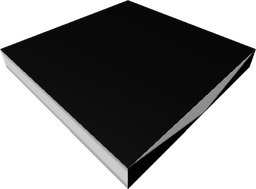Screen

Allows for the programmatic creation of GUI elements.
Internally, it utilises a SurfaceGUI, and is therefore no different from normal roblox GUIs.
There are some limitations with Screens in Waste of Space, such as an inability to use ViewportFrames
It is a craftable and spawnable non-flammable solid.
It consumes 5 power per tick.
Here is a list of possible sizes that reach the maximum malleability (400) that have integer components: 1x1x400, 1x2x200, 1x4x100, 1x5x80, 1x8x50, 1x10x40, 1x16x25, 1x20x20, 2x2x100, 2x4x50, 2x5x40, 2x8x25, 2x10x20, 4x4x25, 4x5x20, 4x10x10, 5x5x16, 5x8x10
At its default size (8x1x8) it has a durability of 1, at its maximum size it has a durability of 2.
By default, its colour is #111111.
It requires 12 Glass, 12 Light, and 8 Silicon to be crafted.
-- Try and get the screen part, throw an error if we don't find it using `assert`.
local screen = assert(Network:GetPart("Screen"), "no screen connected")
-- Create a text label with the text 'Hello, world!' which takes up the entire screen.
local textLabel = Instance.new("TextLabel")
textLabel.Text = "Hello, world!"
textLabel.Size = UDim2.fromScale(1, 1)
textLabel.BorderSizePixel = 0
textLabel.BackgroundColor3 = Color3.fromRGB(255, 255, 255)
-- Parent it to the 'canvas' of the screen.
textLabel.Parent = screen:GetCanvas()
-- Keep the microcontroller on by permanently 'yielding' the code (making it wait).
coroutine.yield()
Methods
ClearElements()
Clears all objects that are descendants of the screen.
CreateElement(className, properties) → element
Creates an element of the specified class name with the specified properties.
The parameters for CreateElement are as follows:
- The className parameter is a
string. - The properties parameter is a dictionary with keys that are
strings and values that areanys.
The element return is an Instance.
-- Try and get the screen part, throw an error if we don't find it using `assert`.
local screen = assert(Network:GetPart("Screen"), "no screen connected")
-- Clear the left over screen elements from the last time GUIs were loaded onto it.
-- Note: If you utilise the `Instance.new` API instead, you do not need to do this,
-- as objects created through said API are *automatically* deleted when the
-- microcontroller stops running.
screen:ClearElements()
-- Call the `CreateElement` method with the `ClassName` of the object you want to create,
-- and a dictionary of the properties to apply (you cannot specify the `Parent` property).
local textLabel = screen:CreateElement("TextLabel", {
Text = "Hello, world!",
Size = UDim2.fromScale(1, 1),
BorderSizePixel = 0,
BackgroundColor3 = Color3.fromRGB(255, 255, 255),
})
-- Keep the microcontroller on by permanently 'yielding' the code (making it wait).
coroutine.yield()
GetCanvas() → canvas
Returns the parent container of all the screen's content.
The canvas return is a Frame.
GetDimensions() → dimensions
Gets the size of the screen in pixels in the form of a Vector2.
The dimensions return is the size of the screen in pixels. It is a Vector2.
-- Try and get the screen part, throw an error if we don't find it using `assert`.
local screen = assert(Network:GetPart("Screen"), "no screen connected")
-- Store the current screen size.
local previousScreenSize = screen:GetDimensions()
-- Connect to the `Loop` event of the `Microcontroller` that is running the code,
-- this will make the code within run precisely every game tick.
Microcontroller.Loop:Connect(function()
-- Get the new current screen dimensions.
local screenSize = screen:GetDimensions()
-- Compare these new dimensions with the previously recorded dimensions, if
-- they are equal, cancel this running code with 'return'.
if screenSize == previousScreenSize then
return
end
-- Do something with the information about the screen dimensions changing,
-- in this case, it triggers a print statement.
print(`The screen size changed! It used to be {previousScreenSize}, but is now {screenSize}!`)
-- Update the stored current dimensions as to make them accurately reflect reality.
previousScreenSize = screenSize
end)
Configurables
VideoID
The ID of the camera feed being to be viewed, or 0 for none. It is a number.
It ranges between 0 and 10000000000. It increments by 1.
Events
Configured(configurerId)
Fires when the object is configured.
The configurerId parameter is the UserId of the player who configured the object. It is a number.